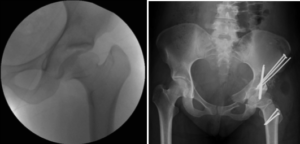Perthes disease is a unique form of femoral head ischemia that usually occurs in young children and less commonly in older children. Children with early Perthes are treated with splinting, containment surgery, and close follow-up. Once Perthes is healed, the function of the hip depends on the final shape and size of the femoral head and the acetabulum. Containment with bracing or surgery maintains femoral head shape when done in the earliest stages of the disease prophylactically. Once the head becomes deformed and subluxated in later stages, containment becomes remedial. Once the head is healed, the prognosis is based almost entirely on the bony morphology and the cartilage space.
In healed Perthes, the cartilage space is usually normal, but can occasionally become narrow portending poor prognosis. 10% of Perthes develop a osteochondral defect. The acetabulum can be normal, retroverted, bilobed, or have lateral dysplasia with subluxation. The femoral head can be normal, enlarged but round (coxa magna), oval, mushroom shaped, flat (coxa plana), or bilobed. The femoral neck can be normal or short (coxa breva). The greater trochanter growth is always normal, but it appears overgrown, when the capital physeal growth is inhibited. The hip function and longevity depend on the collective effect of all the morphological abnormalities.
The treatment can be selective by identifying and treating the most likely cause of hip pain and dysfunction or comprehensive by correcting all potential causes and abnormalities in one stage. Dr. Prasad Gourineni does arthroscopic evaluation and correction of mild asphericity of the head or acetabular retroversion if rest of the morphological variations are mild and not like to cause symptoms. In more severe deformities, all abnormalities are corrected with surgical dislocation approach that allows head reshaping, neck lengthening, GT transfer, and acetabuloplasty.
Coxa magna, breva, vara, and acetabular dysplasia treated with RNL and PAO

